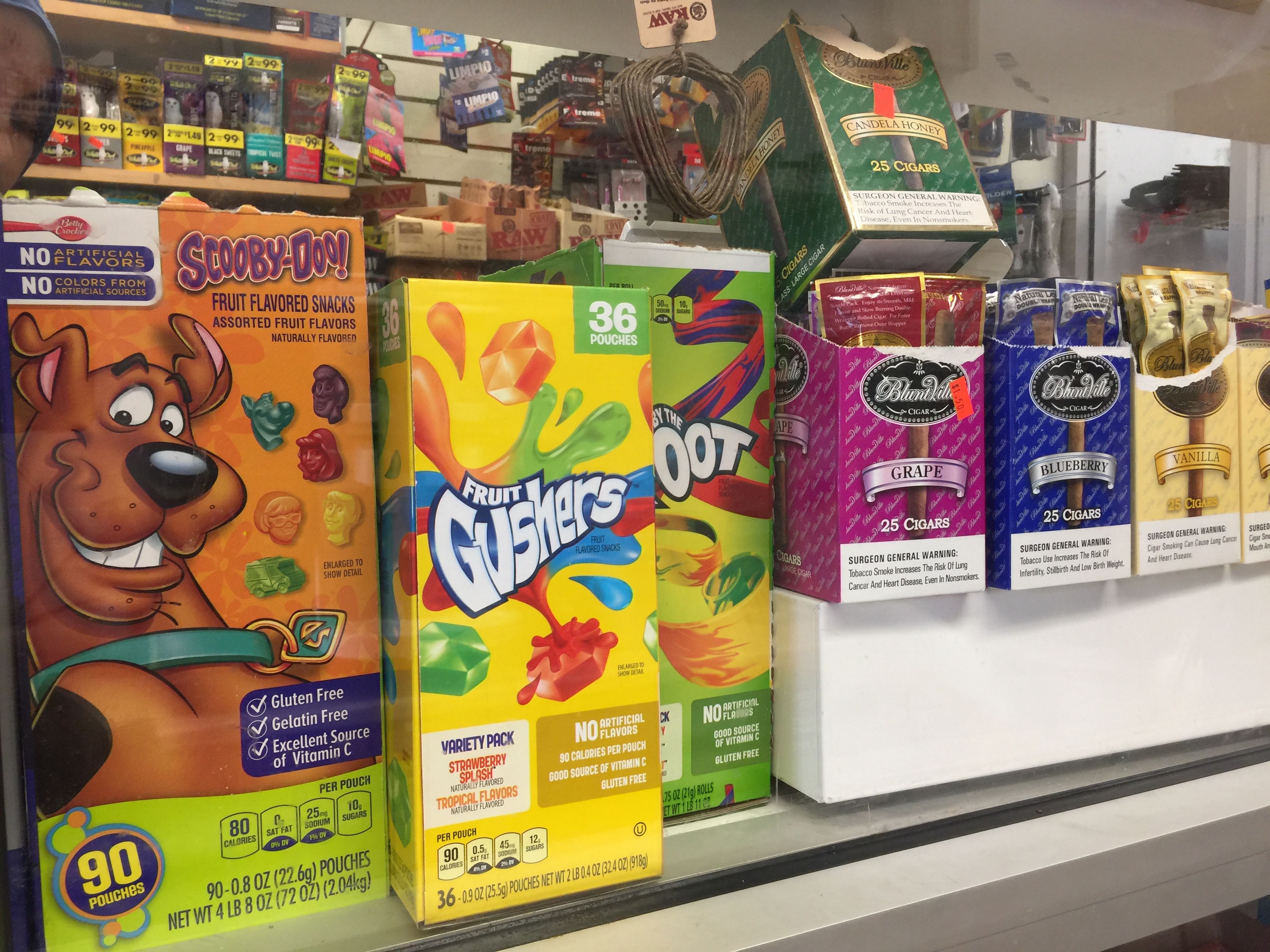Welcome to CounterTobacco.org’s “News and Research Roundup!” Each month we post a summary of the latest research, reports, and news stories on counteracting tobacco product sales and marketing at the point of sale (POS). Keeping up with what’s happening in the POS movement all across the country can help you choose policies and strategies that work best for your community. New research can help provide support for your work and evidence for the importance of the “War in the Store.” Have a story you don’t want us to miss? E-mail it to us!
New Research
Price Promotions
- Receipt of tobacco direct mail coupons and changes in smoking status in a nationally representative sample of US adults, Nicotine & Tobacco Research
- Data from the US Population Assessment on Tobacco and Health (PATH) Study show that 12.4% of US adult non-smokers and 36.2% of US adult smokers reported receiving tobacco coupons through either direct mail or e-mail. Individuals with lower levels of income and education were more likely to receive coupons, regardless of their smoking status. Non-smokers who received coupons were 76% more likely to progress to current smoking than those who did not receive coupons, and current smokers who received coupons were 70% more likely to progress to daily smoking than those who did not receive coupons. Learn more about strategies to prevent the redemption of coupons.
- Banning tobacco price promotions, smoking-related beliefs and behavior: findings from the International Tobacco Control Four Country (ITC 4C) Survey, Tobacco Control
- In countries without bans on price promotions (the United States and Australia), exposure to price promotions was associated with pro-smoking beliefs and with smoking behaviors. These associations were not found in the United Kingdom or Canada, countries that both have policies prohibiting price promotions. Learn more about prohibiting price promotions.
Flavored Tobacco
-

Fruit-flavored cigars and fruit flavored candy Flavors and Risk: Perceptions of Flavors in Little Cigars and Cigarillos Among U.S. Adults, 2015, Nicotine & Tobacco Research
- Those who perceived little cigar and cigarillo flavors as “not at all risky” or “a little risky” were about twice as likely to have ever used flavored little cigars or cigarillos compared to those who reported not knowing the risks. Learn more about flavored tobacco products.
- Menthol levels in cigarettes from eight manufacturers, Tobacco Control
- Menthol-labelled cigarettes comprised about one-third of the US cigarette market in 2012. However, varying levels of menthol were also found to be present in some cigarettes not labeled as menthol. This may be due to contamination in the manufacturing facility, may be added intentionally, or may be part of added complex ingredients. Products from RJ Reynolds (i.e. Newport menthols) and the company’s subsidiary, Santa Fe Natural Tobacco, had the highest levels of menthol.
E-Cigarettes
- Electronic cigarette use among US adults in the Population Assessment of Tobacco and Health (PATH) Study, 2013-2014, Tobacco Control
- According to 2013-2014 data from the PATH study, 5.5% of US adults were current e-cigarette users. Among current users, 42.4% were infrequent users, 36.5% were moderate users, and 21.3% were daily users. Daily use was associated with using rechargeable or refillable devices and with being a former smoker or reporting recently quitting. Nearly 70% of all current e-cigarette users also reported current cigarette smoking. Never smokers were more like to cite flavors as a reason for their e-cigarette use (75.3%) compared with current (63.7%) and former (60.1%) smokers. Reduced harm to self or others was the top reason for use cited.

claims about vaping
- According to 2013-2014 data from the PATH study, 5.5% of US adults were current e-cigarette users. Among current users, 42.4% were infrequent users, 36.5% were moderate users, and 21.3% were daily users. Daily use was associated with using rechargeable or refillable devices and with being a former smoker or reporting recently quitting. Nearly 70% of all current e-cigarette users also reported current cigarette smoking. Never smokers were more like to cite flavors as a reason for their e-cigarette use (75.3%) compared with current (63.7%) and former (60.1%) smokers. Reduced harm to self or others was the top reason for use cited.
- In-person retail marketing claims in tobacco and E-cigarette shops in Southern California, Tobacco Induced Diseases
- In vape and tobacco shops in three different Orange County, CA cities, simulated customers asked salespeople how e-cigarettes compare to conventional cigarettes. The study found that 57% of sales staff claimed that smoking e-cigarettes helps with smoking cessation, 54% talked about e-cigarettes’ various flavors, and 50% claimed that e-cigarettes were healthier than conventional cigarettes. Salespersons in vape shops made more positive marketing claims than those in tobacco shops, however, the number of positive e-cigarette claims made by salespersons also varied by city.
- Association Between Initial Use of e-Cigarettes and Subsequent Cigarette Smoking Among Adolescents and Young Adults: A Systematic Review and Meta-analysis, JAMA Pediatrics
- Pooled probabilities show that adolescent and young adult never smokers who had ever used an e-cigarette were over three times as likely to subsequently initiate cigarette smoking compared to those who never used an e-cigarette. Individuals who reported current e-cigarette use were over four times as likely to report current cigarette use at study follow-up compared to participants who were not current e-cigarette users at baseline.
- Learn more about e-cigarettes at the point of sale.
Other
- Comparison of sampling strategies for tobacco retailer inspections to maximize coverage in vulnerable areas and minimize cost, Nicotine & Tobacco Research
- Conducting tobacco retailer inspections using stratified, clustered sampling at the zip code or census tract level can make the process more efficient by reducing travel costs. It can also help address disparities in compliance rates by providing the ability to target specific areas where there are more likely to be violations (i.e. in areas with high poverty, stores near schools, areas with diverse racial and ethnic populations) with oversampling. While this method provides slightly less statistical precision than simple random sampling, researchers argue that it maximizes the program’s impact. While the FDA does not currently require a probability-based sampling strategy for inspections, researchers argue that the FDA should require the use of this probability-based sampling strategy In order to compare between states and across time while also targeting inspection efforts where they are most needed.
- Impact of five tobacco endgame strategies on future smoking prevalence, population health and health system costs: two modeling studies to inform the tobacco endgame, Tobacco Control
- Researchers compared the following five tobacco endgame strategies: 1) ongoing annual tobacco tax increases of 10% until the year 2024; 2) a tobacco-free generation strategy, where all individuals born after 1993 would never legally be able to purchase tobacco; 3) a sinking lid of the tobacco supply, requiring tobacco companies to reduce the amount of tobacco imported until ending the supply in 2024; 4) a substantial reduction in the number of tobacco retail outlets, by 90% in each local government area in the first 9 years, requiring tobacco retailer licensing, and eventually linking the tobacco retailer cap to population size; and 5) a combination of all of these strategies. They examined each for time delays to health gains and cost savings using two simulation models and found that all strategies were associated with reductions in smoking prevalence and major health gains, though the timing varied by strategy.
-

Graphic warning from Australia Over-Time Impacts of Pictorial Health Warning Labels and their Differences across Smoker Subgroups: Results from Adult Smokers in Canada and Australia, Nicotine & Tobacco Research
- In Canada, cigarette packs are required to have graphic health warning labels on 75% of both the front and back of cigarettes packages as well as inserts with cessation messages. In Australia, cigarette graphic health warning must cover 75% of the front and 90% of the back of the package, and cigarettes must come in otherwise plain packaging that is devoid of marketing. This study found that in both countries over a two-year period of time, smokers’ attention to graphic health warning labels declined, but their cognitive responses (e.g. thinking about quitting or the harms of smoking) and forgoing responses (choosing not to smoke a cigarette after seeing the warning label) increased. Greater increases in responses were seen among smokers with higher income and/or education in both countries and among younger smokers in Australia.
- Special communication: Reducing tobacco-related harm: FDA’s proposed product standard for smokeless tobacco, Tobacco Control
New Reports
Industry News
- R.J. Reynolds Brings Newport Platinum National, Convenience Store News
- NJOY Moves Ahead as New Entity, CSP Daily News
- Tobacco industry gathers signatures to overturn SF’s menthol ban, San Francisco Examiner
POS Policy in the Media
Menthol and Other Flavored Tobacco
 SF bans sale of menthol cigarettes, may eliminate at least $50.5M in tobacco sales, San Francisco Examiner
SF bans sale of menthol cigarettes, may eliminate at least $50.5M in tobacco sales, San Francisco Examiner - Contra Costa Supes Vote Unanimously to Restrict Flavored Tobacco Sales, CBS Local
- The Fierce Urgency of Now: Menthol Tobacco Marketing in African American Communities, Milwaukee Courier
- Minneapolis leaders look to restrict menthol cigarette sales, Star Tribune
- Middletown, R.I. Adopts Flavored Tobacco Restrictions, Requires Tobacco Retailer Licenses, HalfWheel
- Big Tobacco Targets the Black Community, Milwaukee Courier
Tobacco 21
- Oregon Legislature Raises Tobacco Sales Age to 21, Bill Awaits Governor’s Signature, PR Newswire
- Powell bans tobacco sales to those under 21 and medical marijuana businesses, Columbus Dispatch
- Maine bill would hike age to buy tobacco to 21, but still allow smoking at 18, Bangor Daily News
- State lawmakers weigh bill to raise age to 21, New York Post
- Raise the Smoking Age to 21? Most Kids Fine with That, HealthDay
- Health Board Favors Raising Tobacco Purchase Age, But Nixes Other Restrictions, Cape Cod Chronicle
- Plattsburgh City Council supports resolution to raise legal age to buy tobacco, WCAX
- Vernon Hills plans to raise age for tobacco sale to 21, Chicago Tribune
- Christie to decide whether to raise N.J. smoking age to 21, com
- Raise it up? Recent state poll support for increase in tobacco sales age, Petoskey News
- St. Louis Park poised to become second city in state to raise tobacco sales age to 21, Star Tribune
- Harwich Board of Health Recommends Raising Tobacco Purchase Age, CapeCod.com
- Mayor wants tobacco purchase age raised, Elk River Star News
- Easthampton health board listens to input on ‘Tobacco 21’ proposal, MassLive
- Advocates aim to raise tobacco-buying age to 21, St. Cloud Times
Other
- Turn smoking war to poor, Scranton Times-Tribune
- Few barriers for Keizer youth wanting tobacco, Keizertimes
- House panel seeks to block FDA ‘vaping’ rules, Associated Press
- Tobacco companies tighten hold on Washington under Trump, The Guardian
- Inside Philip Morris’ campaign to subvert the global anti-smoking treaty, Reuters
- Big tobacco still sees big business in America’s poor, The Guardian
- A promising decline in teen smoking, Washington Post
Find more stories in last month’s News and Research Roundup.
Know of a story that we missed? Email us, and we’ll be sure to include it in next month’s roundup!


